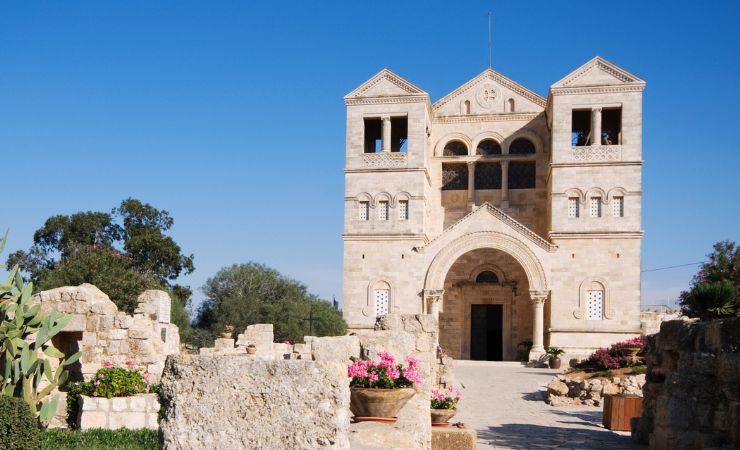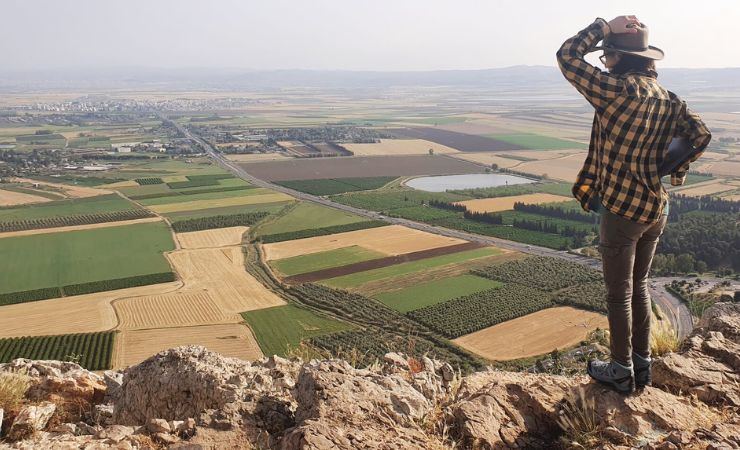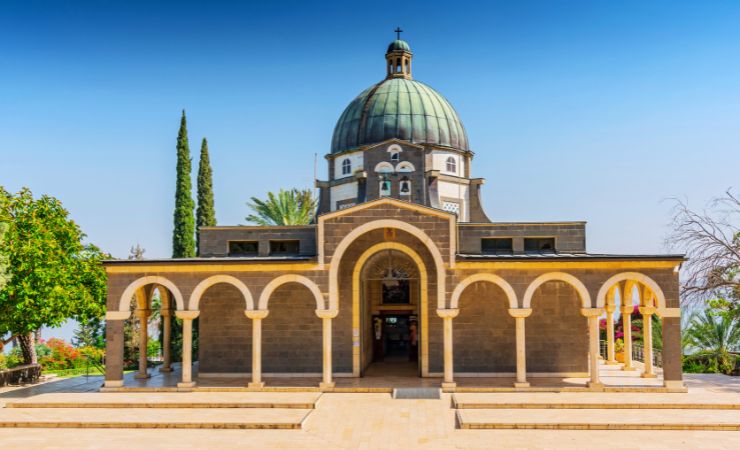Nimrod Fortress: The Stronghold on Mount Hermon's Slopes
Nimrod Fortress is the most impressive medieval fortress in the region, perched on a narrow ridge at the foot of Mount Hermon. Although it never endured a major direct battle, much of its damage is due to centuries of earthquakes. Today, the fortress remains remarkably well-preserved, offering a glimpse into its former strength and significance.
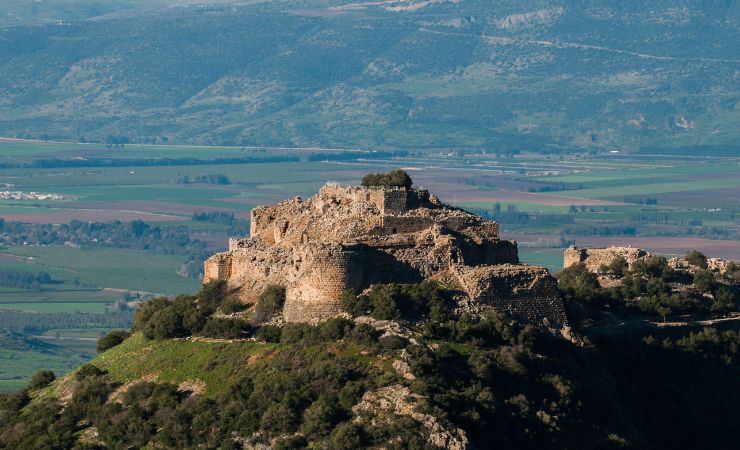
Location
Nimrod Fortress stands in the Golan Heights, on a narrow ridge elevated about 800 meters above sea level, along the southern slopes of Mount Hermon. The Ayyubids, who built it, chose the site carefully to control a key access route from Baniyas to Damascus.
Origin of the Name
The fortress has gone by several names over the centuries. Its original name, Qal’at al-Subeiba, appears in Arabic sources from the 13th century. The meaning of “al-Subeiba” is open to interpretation. Some believe it means “Leaping upon the Prey,” a fitting description when you see the fortress perched dramatically above the Hula Valley, almost like a leopard or lion ready to spring. Others suggest the name comes from the Arabic word ṣabīb, meaning “cliff” or “slope.”
The connection to Nimrod, the biblical king, warrior, and hunter, came much later. In the 19th century, Druze communities who settled in the area during the 1860 conflict began calling it Qal’at Namrud — Nimrod’s Castle. Nimrod, described in the Book of Genesis and the Book of Jasher, was a mighty hunter and a ruler during the time when the world spoke a single language, before the Tower of Babel story unfolded.



The History of the Nimrod Fortress
For many years, researchers believed that Nimrod Fortress had been established by the Crusaders in the late 12th century. However, later studies revealed that the citadel’s foundations were actually laid by the Ayyubid rulers about a century later, around 1227 CE.
The impressive structure we see today was built under the leadership of al-‘Aziz ‘Othman, the ruler of Baniyas, likely funded by al-Malik al-Mu’azzam ‘Isa, ruler of Damascus. Their efforts were part of a larger Ayyubid strategy to defend against a possible attack by Holy Roman Emperor Frederick II. Following an alliance between Salah al-Din’s successor in Egypt, al-Kamil, and Frederick II, al-Mu’azzam and his brother al-‘Aziz ‘Othman launched a major fortification campaign in 1227 CE. Construction lasted about three years, creating a fortress that used the steep cliffs as natural defenses and established the massive, well-protected complex we see today.
An inscription dating from 1228 CE, found at the site, marks the governance of al-‘Aziz ‘Othman. For a long time, historians attributed the fortress to the Crusaders, but in 1989, scholars Ronnie Ellenblum and Reuven Amitai reattributed it to the Ayyubids after analyzing historical sources and inscriptions.
In 1260, the Mongols overthrew the Ayyubids and captured the fortress, along with the nearby city of Baniyas. However, their hold was short-lived. Just a few months later, Baybars, the Mamluk sultan, defeated the Mongols at the Battle of Ain Jalut and seized control of the region. Baybars reinforced and expanded the fortress, eventually granting it to his deputy, Bilik. Bilik carried out major building projects, commemorated by a remarkable Arabic inscription from 1275 CE still visible in the fortress today. Near this inscription, archaeologists found a stone relief of Baybars’ emblem: a lion playing with, or stepping on, a mouse — a symbol of strength found at other sites associated with Baybars, like the Lions’ Gate in Jerusalem and Baybars Bridge in Lod.
Under Mamluk rule, the fortress was expanded to include a palace and a mosque. After the final expulsion of the Crusaders from the Holy Land at the end of the 13th century, however, the citadel’s military importance declined. It continued to serve as a political stronghold and, by the 15th century, functioned as a palace-prison for rebellious nobles. During the Ottoman period, the fortress gradually fell into disuse and was eventually abandoned, standing in ruins for centuries, occasionally offering shelter to shepherds and travelers.
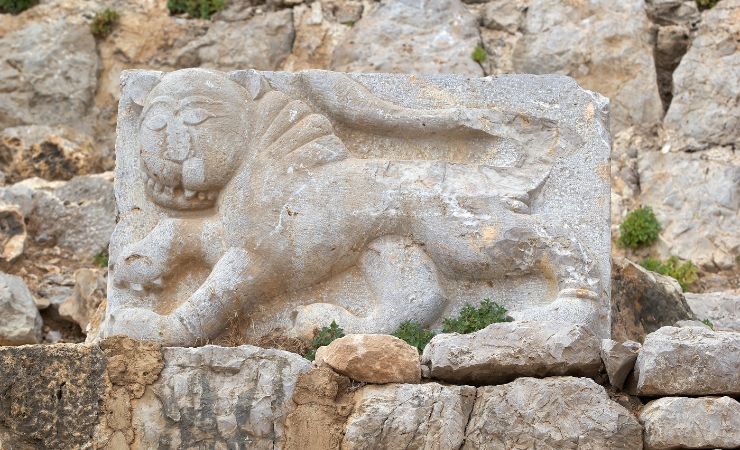
What Can Be Seen at the Site Today
The Southwestern Tower: Serving today as the main entrance, this tower offers sweeping views across the Galilee, the Golan Heights, the Hula Valley, and the slopes of Mount Hermon.
The Keep (Donjon): Located in the eastern part of the fortress, the keep was designed as a fortress within a fortress — a final stronghold in case of siege. Elevated above the rest of the site, it dominates the surrounding gates and defenses. Inside, remains of luxurious halls, water pools, and many rooms suggest it once served as the governor’s residence. The keep is separated from the rest of the complex by a moat hewn directly into the bedrock, once crossed by a wooden bridge. Near the moat’s southwestern corner is the oldest known inscription at the site, dating to 1228 CE during the rule of al-‘Aziz ‘Othman. The keep would have housed essential supplies like a cistern and oven to survive long sieges.
Baybars Inscription: A monumental Arabic inscription from 1275 CE, one of the largest surviving from the Mamluk period. It praises Sultan Baybars and his deputy Bilik, who led extensive building and restoration efforts at the fortress. The inscription likely adorned the second story facade.
Baybars’ Lion Symbol: Close to the inscription is a carved relief of a lion, the personal emblem of Sultan Baybars. Similar carvings can be found at other Baybars-related sites like the Lions’ Gate in Jerusalem and Baybars Bridge in Lod.
The “Beautiful Tower”: This semi-circular tower projects from the fortress’s southern wall. Built by Baybars, its interior is octagonal (now appearing seven-sided due to partial collapse) and features a vaulted roof. The stonework and embrasures here are of particularly fine Mamluk craftsmanship. A small toilet cubicle, surprisingly well-preserved, is tucked into one corner.
The Secret Passage: A hidden, stepped passage about 27 meters long, lined with high vaults. It runs from a northern gate tower to the outside, offering a concealed escape route in emergencies. The passage’s exit was cleverly hidden, reinforced with an arch to distribute the weight of the stones above. Earthquake damage is visible along the route.
Water Cistern: A large, rock-hewn cistern collected rainwater through a network of channels (now mostly destroyed). Nearby, there may once have been a sabil — a public fountain common in Mamluk and Ottoman architecture — symbolizing the ruler’s generosity and providing drinking water to travelers and residents alike.
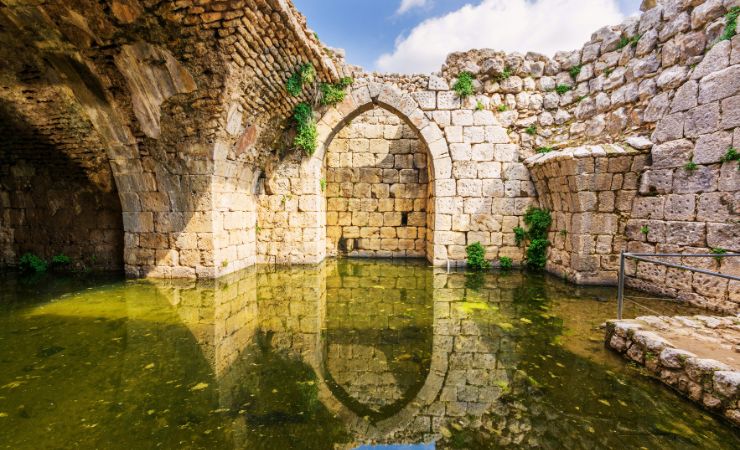
Additional Information
Medieval Period:
- Late 12th Century (after 1187): Following the Battle of Hattin (1187), Salah al-Din’s power rises, marking the beginning of the end for the Crusader Kingdom of Jerusalem.
- Early 13th Century:Salah al-Din’s empire is divided among his Ayyubid successors. Al-Kamil, ruler in Egypt, forms an alliance with Holy Roman Emperor Frederick II, agreeing to cede Jerusalem in exchange for Crusader help against his brother al-Mu’azzam ‘Isa, ruler of Damascus.
- Around 1227: In response to the alliance between al-Kamil and Frederick II, al-Mu’azzam ‘Isa (ruler of Damascus) and his brother al-‘Aziz ‘Uthman (ruler of Baniyas) begin extensive fortification work on Qal’at al-Subayba (Nimrod Fortress). This contradicts earlier theories of Crusader construction.
- 1227-1230: Fortification work continues for about three years, transforming the site into a massive and well-defended fortress.
- 1260: The Mongols conquer the region, including Baniyas and Qal’at al-Subayba, ending Ayyubid rule.
- Shortly after 1260: Mamluk forces under Baybars defeat the Mongols at the Battle of Ain Jalut, taking control of the region, including the fortress.
- Mamluk Period: Baybars expands and strengthens the fortress. He grants the fortress and Baniyas to his deputy, Bilik.
- 1275: An inscription commemorating Baybars’ construction work is placed at the fortress, mentioning Baybars, Bilik, and the builders. A stone with Baybars’ symbol, a young lion playing with a mouse, is found near the inscription. BaYbars elevates the status of the fortress and Baniyas to a governorship underyDamascus, directly appointed by the Sultan in Cairo.
- 15th Century onwards: The fortress serves as a palace-prison for nobles who rebelled against the central Mamluk authority.
Ottoman Period:
- 19th Century: The name “Nimrod” is first mentioned in Ottoman documents, referring to the fortress.
- 1867: Mark Twain visits the Holy Land and describes Nimrod Fortress as “the noblest ruin of its kind in the world.”
Modern Period:
- After 1967:Immediate survey of landscapes and sites in the Golan begins after the Six-Day War, led by Shmarya Gutman.
- Late 20th Century/Early 2000s: Archaeological research at Nimrod Fortress concludes it was primarily built by the Ayyubids in the 13th century, contradicting earlier theories.
Nearby Sites
- Banias Nature Reserve (Caesarea Philippi): Features the Banias Waterfall — the largest in Israel — along with ancient ruins and trails.
- Mount Hermon: Israel’s highest peak offers hiking trails in the summer and skiing in the winter.
- Tel Dan Nature Reserve: A beautiful combination of flowing rivers, dense greenery, and archaeological remains.
- The Druze Village of Majdal Shams: This vibrant village offers authentic Druze food, culture, and beautiful views over the Golan.

